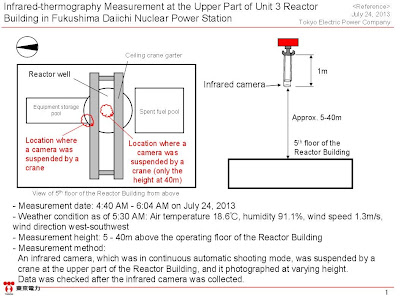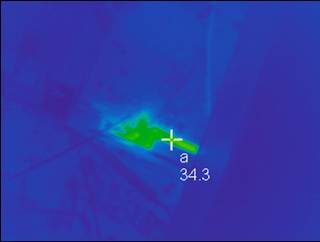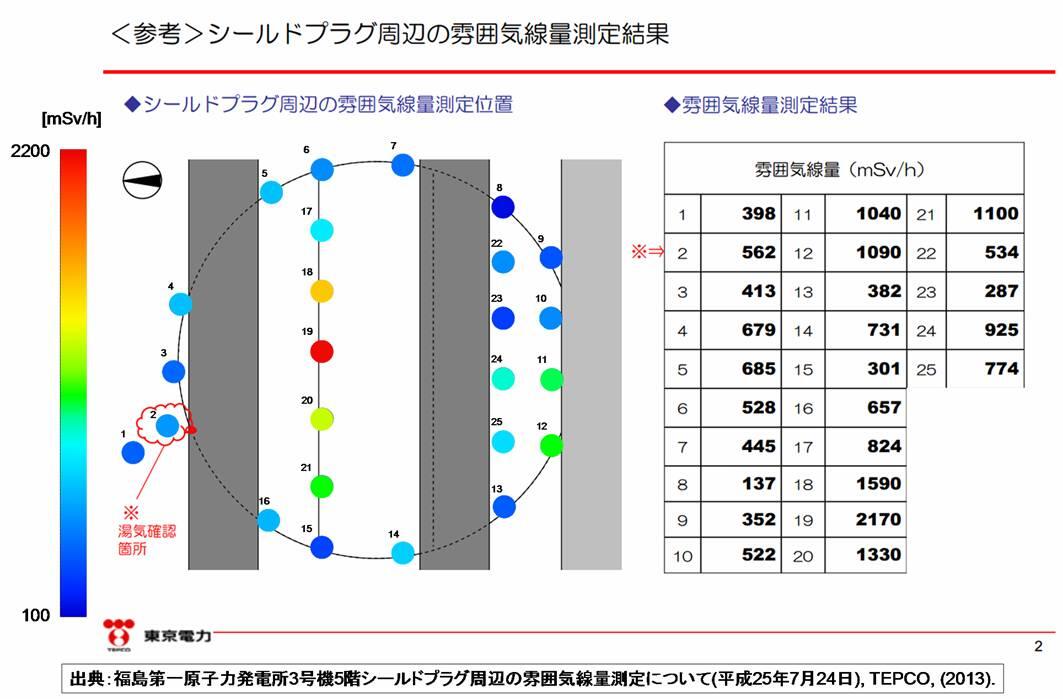(UPDATE 7/27/2013) TEPCO just released (7/28/2013) the data on tritium from this observation hole (B1-1): 8,700,000 Bq/L.
The observation hole No.1-2 has been consistently found with high levels of tritium, with most recent measurement at 350,000 Bq/L from the sample taken on July 22, 2013.
=============================
5,000 cubic meters, or 5,000 tonnes of this water is in the trench.
It's one thing or another at Fukushima I Nuclear Power Plant, and now it's back to contaminated groundwater along the seawall.
After sheepishly admitting the groundwater that got somehow contaminated along the way to the seawall may have been seeping into the sea after all (but only into the open culvert outside water intake canals enclosed by the silt screen, not even inside the plant harbor), TEPCO took samples from the trench for electrical wires and seawater pipe that connects Reactor 2 turbine building and the water intake for Reactor 2 in an effort to identify the source of contamination of the groundwater sampled along the seawall.
The trench for electrical cables is where the extremely contaminated water was flowing freely from the Reactor 2 turbine building into the open culvert back in April 2011.
The surface radiation level of that water in April 2011 was over 1 Sievert/hour (the survey meter went overscale).
The Reactor 2 turbine building basement is filled with contaminated water that comes from the reactor building every day as water is being injected to cool the corium, though the density of radioactive materials is being diluted daily with groundwater that seeps into the reactor/turbine building.
TEPCO just announced the result of the analysis of the sample taken on July 26, 2013 from the trench, and to be expected, the result was comparable to the highly contaminated water back in April 2011.
From TEPCO's email notice for the press, 7/27/2013 (part):
...本日(7月27日)、海側トレンチ内高濃度汚染水の汚染源の特定などの調査の一環として、新たに観測孔を設置した2号機取水電源ケーブルトレンチ(B1-1:海水配管基礎部)の7月26日に採取した測定結果が以下の通りとりまとまったことからお知らせします。...
Today (July 27), we would like to announce the result of the analysis of the sample taken on July 26 from a new observation hole in the Reactor 2 water intake electric cable trench (B1-1: at the foundation of seawater pipe trench) as follows.
平成23年4月に発生した2号機取水口スクリーン室への漏えい水の濃度と比較すると同程度となっております。
The numbers are comparable to those of the water leaked to the Reactor 2 water intake screen room, which happened in April 2011.
<B1-1:2号機取水電源ケーブルトレンチ(海水配管基礎部)>
・7月26日採取分:
塩素 8,000 ppm
セシウム134 7億5千万 Bq/L(75万 Bq/cm3)
セシウム137 16億 Bq/L(160万 Bq/cm3)
全ベータ 7億5千万 Bq/L(75万 Bq/cm3)
B1-1: Reactor 2 water intake/electric cable trench (foundation of seawater pipe trench)
Sample collected on 7/26/2013:
Chloride: 8,000 ppm
Cesium-134: 750 million Bq/L (750,000 Bq/cm3)
Cesium-137: 1.6 billion Bq/L (1.6 million Bq/cm3)
All-beta: 750 million Bq/L (750,000 Bq/cm3)
<B2:2号機取水電源ケーブルトレンチ>(お知らせ済み)
・7月17日採取分:
塩素 70 ppm
セシウム134 1200万 Bq/L(1万2千 Bq/cm3)
セシウム137 2400万 Bq/L(2万4千 Bq/cm3)
全ベータ 2300万 Bq/L(2万3千 Bq/cm3)
B2: Reactor 2 water intake/electric cable trench (result already announced)
Sample collected on 7/17/2013
Chloride: 70 ppm
Cesium-134: 12 million Bq/L (12,000 Bq/cm3)
Cesium-137: 24 million Bq/L (24,000 Bq/cm3)
All-beta: 23 million Bq/L (23,000 Bq/cm3)
<平成23年4月の2号機取水口スクリーン付近から漏えいした汚染水の性状>
・セシウム134 18億 Bq/L(180万 Bq/cm3)
セシウム137 18億 Bq/L(180万 Bq/cm3)
Contaminated water that leaked from near the Reactor 2 water intake screen in April 2011
Cesium-134: 1.8 billion Bq/L (1.8 million Bq/cm3)
Cesium-137: 1.8 billion Bq/L (1.8 million Bq/cm3)
It does look like the same water that leaked in April 2011, and it looks like the water has been sitting inside the trench after TEPCO managed to stop the leak. The density of radioactive materials in the water in the duct is higher than the water in the turbine building. The question is whether the water is leaking outside the duct, and how to find that out.
Location of the trench, from TEPCO (7/26/2013; page 5, English labels are mine):
When the highly contaminated water was found leaking (the red circle in the picture above), all TEPCO and everyone else cared about was the electrical cable duct - the one in yellow. I do not think TEPCO looked into the duct for seawater pipe - the one in green - at all.
According to the same TEPCO information dated 7/26/2013, the amount of contaminated water in the trench for seawater intake pipe for Reactor 2 is about 5,000 m3, or 5,000 tonnes. The similar trench for Reactor 3 has about 6,000 m3, or 6,000 tonnes:
The density of radioactive materials for Reactor 2 seawater duct in the table above is the data from July 17, 2013 above. With the data from July 26, 2013, the density is in the same order of magnitude as that for Reactor 3 seawater duct.























 Tokyo Time
Tokyo Time
![[Most Recent Quotes from www.kitco.com]](http://www.kitconet.com/charts/metals/gold/t24_au_en_usoz_2.gif)

